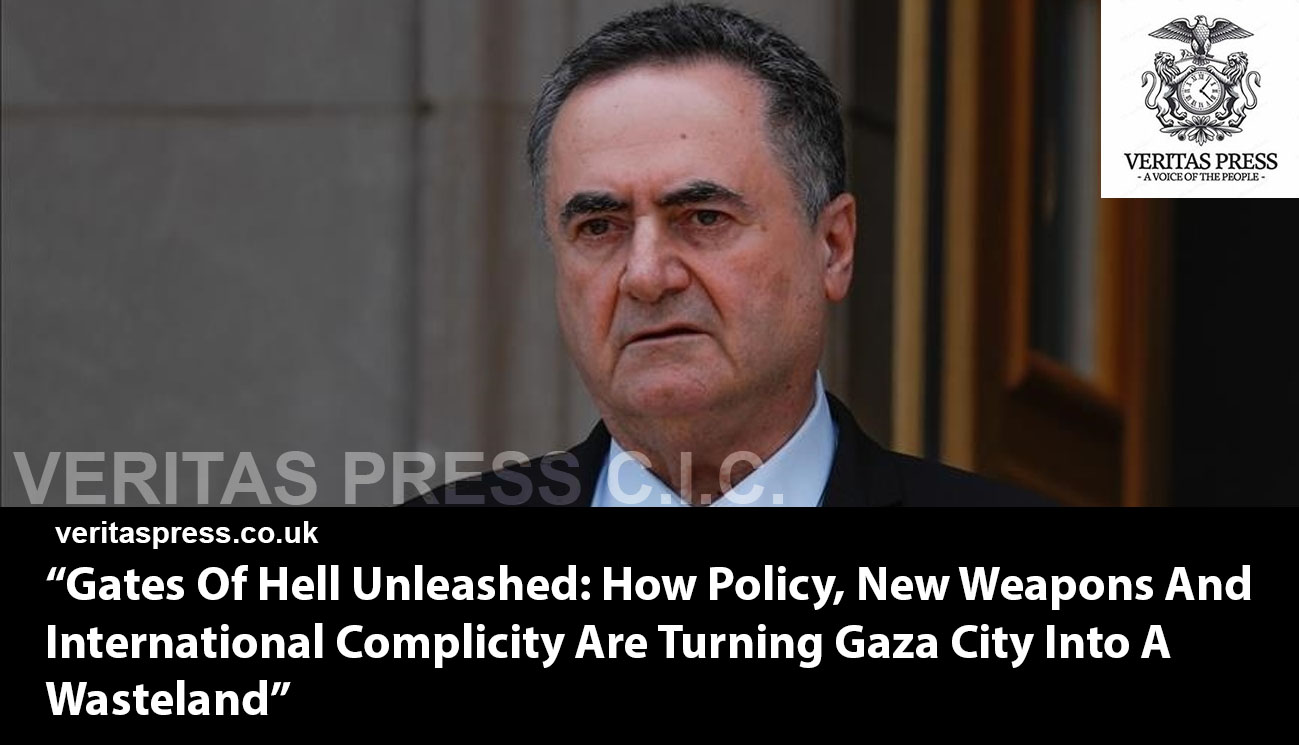Press Release: Veritas Press C.I.C.
Author: Kamran Faqir
Article Date Published: 14 Aug 2025 at 10:50 GMT
Category: Middle East | Palestine-Gaza | US-Israel At War
Source(s): Veritas Press C.I.C. | Multi News Agencies
JERUSALEM & WEST BANK — Israel’s Finance Minister Bezalel Smotrich moved to revive the most explosive settlement plan in the occupied West Bank, saying he has approved tenders for 3,401 housing units in the E1 corridor between Jerusalem and Ma’ale Adumim, a step he billed as the moment that “buries the idea of a Palestinian state.”
If realised, E1 would stitch Ma’ale Adumim to Jerusalem with a chain of new homes, roads and infrastructure that diplomats and planners, including some Israeli experts, have long warned would sever East Jerusalem from the northern West Bank and bisect Palestinian population centres, making a contiguous Palestinian state nearly unattainable.
Smotrich, a far-right settler leader who also holds a key portfolio in the Defence Ministry that oversees civilian planning in the West Bank, framed the move as an act of historical rectification after years of freezes: “After decades of international pressure and freezes, we are breaking conventions and connecting Ma’ale Adumim to Jerusalem. This is Zionism at its best.”
There was no immediate endorsement from Prime Minister Benjamin Netanyahu, whose governments have repeatedly flirted with E1 before backing off under international pressure. The plan still requires additional statutory steps by Israel’s High Planning Council; if those pass, infrastructure could start within months and house-building within about a year, settlement monitors say.
What’s New, And Why Now?
The announcement is the most significant movement on E1 since 2012, when the project last advanced and was then frozen amid outcry from the United States and European partners. It lands as Smotrich faces slumping poll numbers and as Israel’s war in Gaza continues to reshape regional and domestic politics. The timing looks calculated to shore up the governing coalition’s ultra-nationalist base and to force the government’s hand on a flagship ideological goal, multiple analysts told this publication.
Settlement advocates erupted in celebration. Israel Gantz, head of the Yesha Council and Binyamin Regional Council, hailed a “tremendous and historic achievement for the settlement movement” and a “true revolution” in strengthening the enterprise. Ma’ale Adumim’s mayor, Guy Yifrach, called the build-out a “Zionist response of settlement and nation-building.”
But opposition from civil society, diplomats and planners was immediate and scathing. Peace Now warned: “The E1 plan is deadly for the future of Israel and for any chance of achieving a peaceful two-state solution. We are standing at the edge of an abyss.” The group also reported parallel approvals for 3,300 homes in Ma’ale Adumim and additional tenders across the West Bank.
Internationally, Smotrich is already under targeted sanctions from the UK, Canada, Australia, New Zealand and Norway for inciting violence against Palestinians in the West Bank, a move that underscores how E1 will amplify diplomatic friction with Israel’s closest allies.
On The Ground: Who Stands To Lose?
E1 is not just cartography. It’s home, precarious home, to Jahalin Bedouin communities such as Khan al-Ahmar, Abu Nuwar and Jabal al-Baba, repeatedly flagged by UN agencies and rights groups as at risk of forcible transfer, a grave breach of international law. “We are deeply concerned,” UN officials said during earlier field visits, urging Israel to halt demolitions and relocation plans.
Residents describe a slow grind of restrictions and demolitions that create a coercive environment. One community leader told OCHA officials that authorities presented “no choice but to move” to designated relocation sites, a pattern documented for years around Ma’ale Adumim.
The pressure is economic, too. In recent academic fieldwork, a Khan al-Ahmar resident recounted losing his Israeli work permit after protesting demolitions: “When I lost my permit, my whole family lost its only source of income… I’ve sold two-thirds of my cattle to survive.” Such testimonies illustrate how mobility and livelihood are leveraged to deter dissent.
The Planning Logic And Its Critics:
Proponents argue E1 is vital for “Jerusalem’s strategic depth” and the continuity of the Ma’ale Adumim bloc. “Understanding Israeli interests in the E1 area,” a position paper often cited by supporters, frames the corridor as a defensible, logical expansion of Jerusalem’s metropolitan footprint.
But urbanists and legal scholars counter that E1 would lock in a ring of Israeli control around East Jerusalem while fragmenting Palestinian space into disconnected cantons. Daniel Seidemann, a veteran Jerusalem planner, says the current government’s push shows it is “impervious to international engagement” and increasingly willing to green-light E1 and the demolition of Khan al-Ahmar to satisfy its base. Diana Buttu, a Palestinian human rights lawyer and former PLO legal adviser, puts it bluntly: “Israel is going to kill off even the symbols of the idea of an independent [Palestinian] state… [that Palestinians] are forever going to be subjugated.”
Law, Legitimacy And A Hardening Rights Discourse:
Most of the international community views Israeli settlements in the West Bank as illegal under the Fourth Geneva Convention. The rights discourse is hardening: B’Tselem and Physicians for Human Rights–Israel recently issued reports accusing Israel of grave international crimes in Gaza and systemic violations in the West Bank, findings Israel rejects, while warning that policies like E1 entrench a “one-state reality” of unequal rights.
UN human rights officials have repeatedly cautioned that demolishing Khan al-Ahmar or relocating its residents would constitute a forcible transfer. European governments have likewise warned that razing the village would be a “severe blow” to Palestinian development prospects in Area C.
Politics By Bulldozer: Who Benefits?
Investigative takeaway: Smotrich’s move is less about housing demand than irrevocably reshaping the political map. The scale and placement of E1, coupled with road projects that restrict Palestinian access while accelerating settler mobility, point to a coordinated annexation playbook advanced through planning committees, tenders and asphalt, not formal declarations. Settlement monitors refer to this as “de facto sovereignty” by design.
It also functions as political theatre. With his party polling poorly, Smotrich appears to be staking out maximalist terrain that constrains Netanyahu and forces coalition partners to choose between alienating allies abroad or alienating their base at home. That gambit, analysts say, is high-risk, inviting sanctions, legal challenges and diplomatic isolation, but it keeps Smotrich at the centre stage of Israel’s domestic battle over the country’s future borders and identity.
What To Watch Next:
- Statutory chokepoints: Will the High Planning Council fast-track detailed plans and infrastructure permits, or will legal petitions slow the process?
- International pushback: Do allied capitals escalate beyond individual sanctions to material penalties tied to settlement expansion?
- Bedouin communities: Any movement toward eviction or relocation of Khan al-Ahmar, Abu Nuwar, or Jabal al-Baba would signal that E1 is moving from blueprint to ground truth.
Voices From The Fault Line:
- Bezalel Smotrich, Israeli finance & settler affairs minister: “Approval of construction plans in E1 buries the idea of a Palestinian state… After decades of international pressure and freezes, we are breaking conventions and connecting Ma’ale Adumim to Jerusalem.”
- Peace Now (settlement watchdog): “We are standing at the edge of an abyss… [E1 is] deadly for the future of Israel and for any chance of a peaceful two-state solution.”
- Daniel Seidemann, Jerusalem planner: “[Netanyahu] is impervious to international engagement… so cornered and so desperate that he will soon be giving a green light to approve E1 and the demolition of Khan al-Ahmar.”
- Diana Buttu, human-rights lawyer: “Israel is going to kill off even the symbols of the idea of an independent state… [Palestinians] are forever going to be subjugated.”
- Khan al-Ahmar resident (name withheld): “When I lost my [work] permit, my whole family lost its only source of income… I’ve sold two-thirds of my cattle to survive.”
- Israel Gantz, Yesha Council: “A tremendous and historic achievement for the settlement movement… a true revolution.”
- Guy Yifrach, mayor of Ma’ale Adumim: “[This] will connect Ma’ale Adumim to Jerusalem and serve as a Zionist response of settlement and nation-building.”
Bottom line: E1 has always been more than just a neighbourhood. It’s a fulcrum on which the viability of a two-state solution outcome, and the daily lives of thousands of Palestinians, turn. By moving E1 from limbo toward implementation, Smotrich is not merely approving housing units. He is testing how much annexation by paperwork the world will tolerate, and how much fragmentation Palestinians can survive. The next decisions, in planning rooms, courtrooms and foreign ministries, will show whether this is a bluff for leverage or the blueprint for a permanent new map.
In Summary: Annexation In Slow Motion.
The E1 revival is not a housing policy; it is a cartographic weapon. Behind Smotrich’s triumphant rhetoric lies a deliberate state strategy to redraw the West Bank in ways that permanently fracture Palestinian society while cementing Israeli sovereignty without ever declaring formal annexation. The bulldozers may arrive in months, but the political earthmoving has been underway for decades, through planning councils, budget lines, access roads, and the slow suffocation of Bedouin communities caught in the crosshairs.
This annexation plan has been in slow motion since 1948, advancing not in a single dramatic stroke but through a calibrated sequence of land seizures, settlement approvals, military orders, and “temporary” measures that quietly became permanent. E1 is simply the latest link in a chain stretching back to the Nakba, a continuation of the same territorial logic that has defined Israeli policy from the state’s inception.
The government frames this as “Zionism at its best,” yet the blueprint it advances is less about nation-building than nation-unmaking, the erasure of any viable Palestinian state. E1 is the hinge on which that erasure swings, sealing off East Jerusalem, slicing the West Bank in two, and transforming occupied territory into a permanent patchwork of enclaves. Driving Palestinians into small, tightly controlled “zones” while claiming they have chosen to migrate voluntarily is false rhetoric; these zones are not for preservation but for erasure, engineered spaces where political, economic, and social life is designed to wither.
For Palestinians in places like Khan al-Ahmar, the threat is not abstract diplomacy but an approaching reality: loss of land, forced displacement, and the collapse of already fragile livelihoods. For Israel’s allies, E1 will be a litmus test of whether international law still carries weight in the face of calculated, incremental annexation. Smotrich’s gamble is that the world’s outrage will remain rhetorical, and that “facts on the ground” will harden into facts in law. If he’s right, the two-state solution will not die with a treaty or a declaration; it will be buried under 3,401 slabs of poured concrete, one tender at a time.
Tags:













Leave a Reply